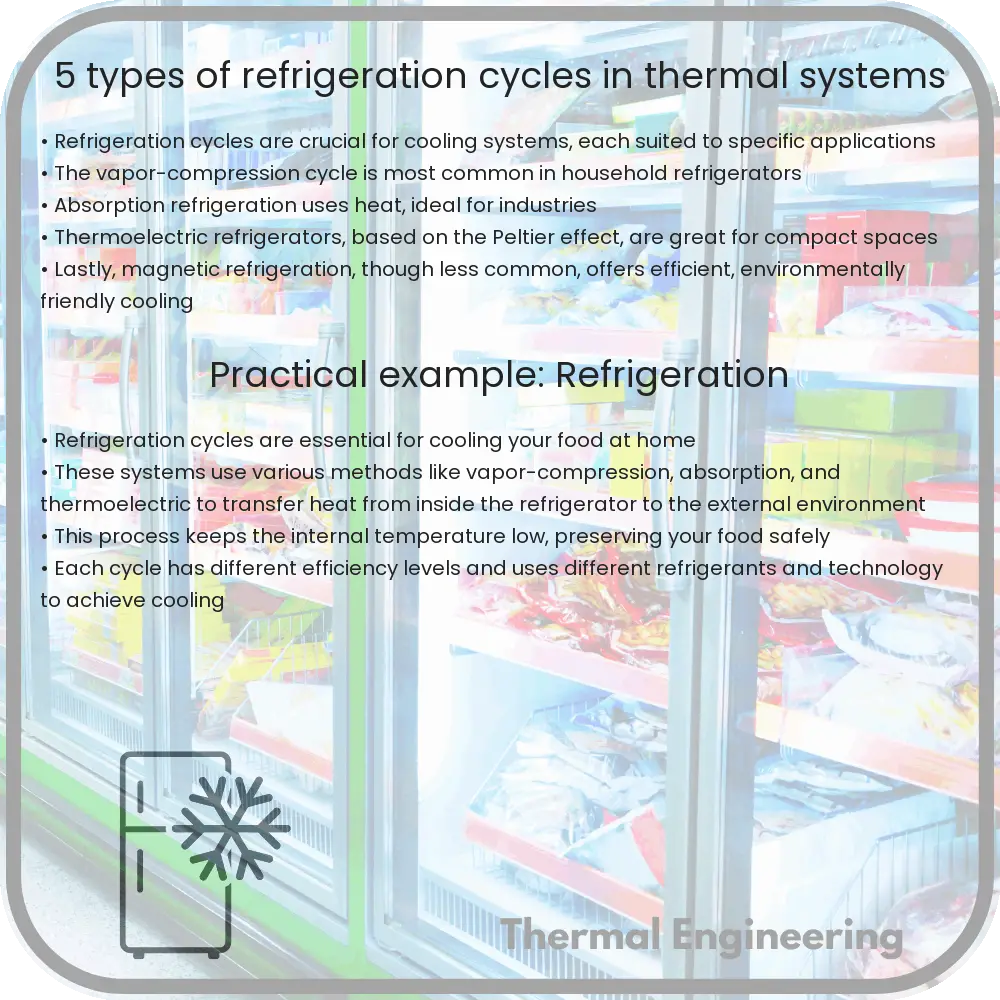Learn about the various refrigeration cycles used in thermal systems, including vapor compression, absorption, gas refrigeration, steam jet, and thermoelectric cycles.

Understanding the Different Types of Refrigeration Cycles in Thermal Systems
Refrigeration is a critical process used in various applications, from preserving food in our kitchens to sophisticated cooling systems in industrial processes. Central to all refrigeration systems is the refrigeration cycle, a process that removes heat from a low-temperature reservoir and transfers it to a high-temperature reservoir. The efficiency and application relevance of a refrigeration system depend largely on the type of refrigeration cycle it uses. This article explores five common types of refrigeration cycles employed in thermal systems.
1. Vapor Compression Cycle
The vapor compression cycle is the most widely used cycle for refrigeration, air conditioning, and heat pumps. This cycle uses a refrigerant in a closed loop and includes four basic components: the compressor, condenser, expansion valve (or throttle valve), and evaporator.
- Compressor: It compresses the refrigerant, increasing its pressure and temperature.
- Condenser: Here, the high-pressure vapor is cooled and condenses into a liquid as it loses heat to the surroundings.
- Expansion Valve: The liquid refrigerant’s pressure is reduced as it passes through the valve, causing some of it to evaporate and cool.
- Evaporator: The cold, low-pressure refrigerant absorbs heat from the enclosed area or substance to be cooled, turning back into a vapor.
2. Absorption Refrigeration Cycle
The absorption refrigeration cycle is similar to the vapor compression cycle, but it replaces the compressor with an absorber and a generator. These cycles typically use ammonia or water as the refrigerant and an absorbent like water or lithium bromide.
- Absorber: It absorbs the refrigerant into the absorbent, which is then pumped to the generator.
- Generator: Here, heating (often through external heat from gas or solar energy) separates the refrigerant from the absorbent.
- Condenser, Expansion Valve, and Evaporator: The separated refrigerant then flows through these components similarly to the vapor compression cycle.
3. Gas Refrigeration Cycle
Gas refrigeration cycles, typically known as Bell Coleman cycles, use gas instead of a liquid refrigerant. Common in aircraft cooling systems, this cycle involves no condensation or vaporization processes. The cycle includes a compressor, a counter-flow heat exchanger (acting as a cooler), an expansion turbine, and another heat exchanger for heating.
- Compressor: Compresses the gas, increasing its temperature and pressure.
- Cooler: The compressed gas is cooled at constant pressure in this heat exchanger.
- Turbine: The cool, high-pressure gas expands in the turbine, reducing its temperature and pressure.
- Heater: The gas then absorbs heat in the second heat exchanger, repeating the cycle.
4. Steam Jet Refrigeration Cycle
Utilizing the principles of evaporation and condensation under reduced pressure, steam jet refrigeration systems are often employed where cooling loads are immense, such as in large air conditioning systems or industries.
- Steam Ejector: Creates a vacuum that draws in the refrigerant and compresses it.
- Evaporator: The water (commonly used as a refrigerant) boils under low pressure and temperature, absorbing the required latent heat of vaporization from the substance to be cooled.
- Condenser: The water vapor then condenses, releasing the absorbed heat. It is recycled back into the system.
5. Thermoelectric Refrigeration Cycle
Thermoelectric refrigeration utilizes the Peltier effect, where heat is absorbed or released when electrical current passes through the junction of two different materials.
- Peltier Module: When a DC current flows through the module, it causes one side to absorb heat and the other side to release it. This creates a temperature differential capable of cooling an isolated environment.
The selection of a refrigeration cycle is crucial and depends on factors such as energy efficiency, cost, operational requirements, and environmental impact. Each type of cycle has its specific advantages and applications, showcasing the versatility and adaptability of refrigeration technology in meeting diverse cooling needs.